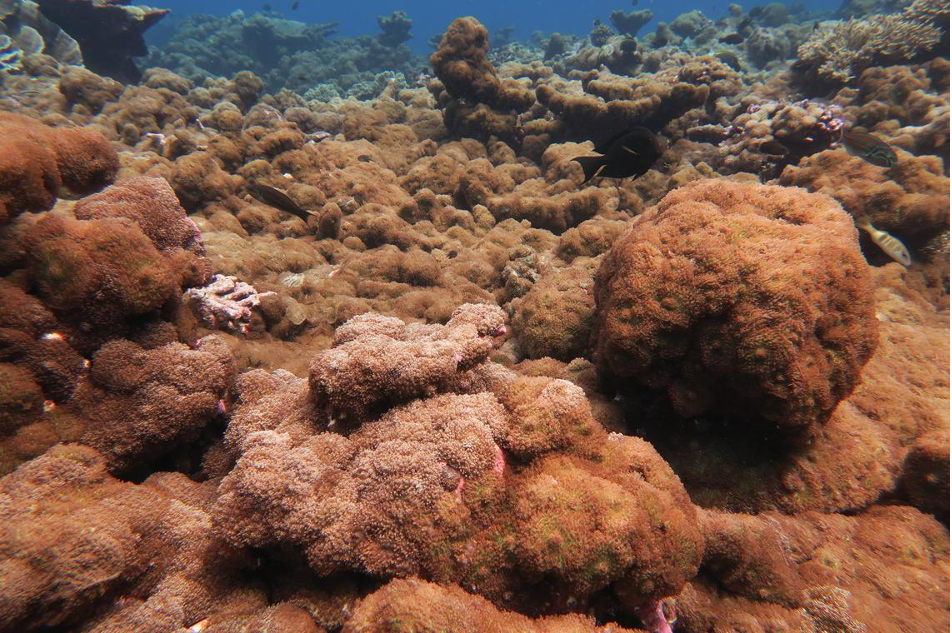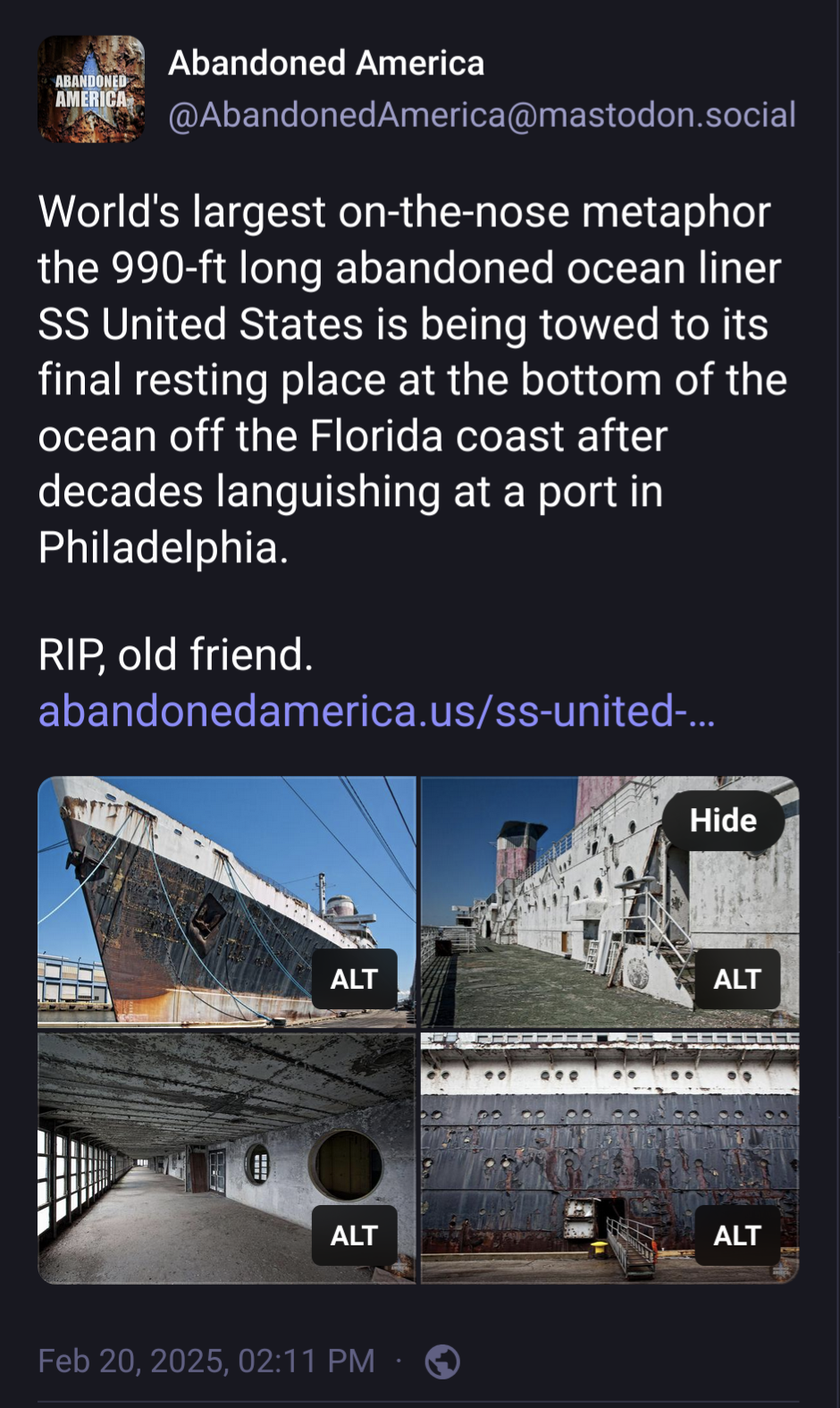It seems ridiculously irresponsible to just sink our old ships when we're done with them.
I dunno, artificial reefs seem like decent way to reuse them. If the metal was worth salvaging seems like the would have. Maybe too labor intensive? https://ocean.si.edu/ecosystems/coral-reefs/when-wrecks-become-reefs
Very cool read! I learned a lot. Let me quote a few interesting passages.
Fish do congregate around wrecks and make them their new homes, but (emphasis mine):
Paxton, Taylor and their colleagues are working to further understand how fish use artificial reefs, and if new human-made reefs prompt fish populations to grow or just pull them from elsewhere. “Are these fish being taken away from nearby natural habitats, or over time are new fish actually being produced?”
Not to mention pollution potential, even from basic building materials like iron that persist after intentional scrubbing and decontamination:
Almost anything can become a reef under the right environmental conditions. But many objects can be sources of underwater pollution in their original states. Toxic paints, asbestos, iron and rusting metal particles can seep out of the structure and into the surrounding waters. Because of this, official reef-creation projects include extensive cleaning and decontamination before the structure or object is sunk into place. That’s not possible, of course, in the case of shipwrecks, which often sink and are abandoned in times of duress or bad weather and only are rediscovered as artificial reefs years later.
For example, scientists have noted instances of iron leaching from sunken ships and having adverse knock-on effects on surrounding reef life. In 2008 at Palmyra Atoll, a reef formation and U.S. National Wildlife Refuge south of Hawaii, researchers observed an invasion of a type of sea anemone called a corallimorph around a shipwreck. The vessel, which ran aground in 1991, was moored to the ocean floor by iron chains. Algae need iron to grow, but the element isn’t plentifully available in many parts of the central and south Pacific Ocean, so its sudden abundance prompted an explosion of algae and an unbalanced invasion of the corallimorphs. The overgrowth, dubbed a “black reef” by scientists due to the anemones’ dark coloration, stretched for over half a mile around the shipwreck and smothered the existing coral in the area.

Invasive corallimorphs, a type of sea anemone, crowd out coral around a shipwreck site at the Palmyra Atoll National Wildlife Refuge in the central Pacific Ocean. (Thierry Work, USGS)
The shipwreck was removed in a multimillion-dollar restoration project spearheaded by the U.S. Fish and Wildlife Service in 2013. In the years since, scientists have had some success with attempts to rid the reef of lingering corallimorphs with pulverized bleach, a treatment that could be used at other similar sites. The Palmyra Atoll is renowned for its biodiversity (it’s home to three times as many coral species as the Hawaiian Islands), and scientists hope the restoration and removal efforts will help retain the area’s abundant marine life.
So, it sounds like these wrecks can become habitats, but they aren't as biodiverse as natural coral reefs and can have other negative consequences. If we've destroyed the natural habitat, then these can be band-aid replacements so the fish at least have somewhere to go. If the natural habitat still exists in an area, then that natural habitat is much healthier without contamination.
They're usually sank in areas that are otherwise uninhabited by corals due to the depth of the water. The wrecks provide surfaces in the light zone which allows corals to grow.
It's entirely new habitat and it provides more breeding sites in the area. Even if it takes wildlife from other areas, the decrease in population in those results in higher breeding rates in those locations due to decreased competition for food and breeding sites. More breeding sites = more breeding and a higher overall population of wildlife over time.
Ecology aside, these sites draw a lot of tourism. They're "shipwrecks" that are in shallow water, often shallow enough that you can experience them while scuba diving, without needing decompression stops. This means that scuba divers can experience wreck diving without the extra complexity of decompression.
There are many of these artificial reefs around Florida and they're very popular dive sites in areas that otherwise would have no similar attractions.
Source: Dated a woman who worked at fish and wildlife, department of marine fisheries and attended the sinking of the Oriskany ( https://www.padi.com/dive-site/united-states-of-america-usa/uss-oriskany/#overview )
Yeah, I feel like there'd be a lot of salvageable material that could be put to better use. Even if it's all rusted and broken down, a ship that size has a lot of steel that could be repurposed.
On the one hand yes. But, and this is a big but, typically when ships are sunk by the government, a lot of environmental impact studies and decontamination processes are preformed. The goal is usually to create artificial reefs, which is pretty useful because of how much damage we’ve done to the natural habitats.
Does it balance out, or make up for it? I don’t know, I’m not smart enough. But I do know the artificial reef projects are greatly appreciated and highly desired by local governments.
Also, shipbreaking is really dirty, dangerous, and expensive, typically being outsourced to some 3rd world country.
They spend a lot to decommission the ships and make them safe. It's just cheaper to buy an old ship and clean it up than to buy a similar amount of other artificial reef materials.
Also, being ships in shallow water, it drives scuba diving tourists as well as creating new locations for recreational fishing.
They're pretty big boons for the local towns.
Yeah, but it's not "profitable".
It's being sunk to create artificial reef
I’ve always kinda wondered what happens once the salt water breaks down the metal and paint, can’t be great for the local ecology
If you think the paint contamination after decommissioning is bad, just wait 'til you find out about how antifouling bottom paint (whether hard copper-based or ablative) works during the service life of the ship, by design.
This is your friend, Mike Brady from Oceanliner Designs…
Microblog Memes
A place to share screenshots of Microblog posts, whether from Mastodon, tumblr, ~~Twitter~~ X, KBin, Threads or elsewhere.
Created as an evolution of White People Twitter and other tweet-capture subreddits.
Rules:
- Please put at least one word relevant to the post in the post title.
- Be nice.
- No advertising, brand promotion or guerilla marketing.
- Posters are encouraged to link to the toot or tweet etc in the description of posts.
Related communities:
